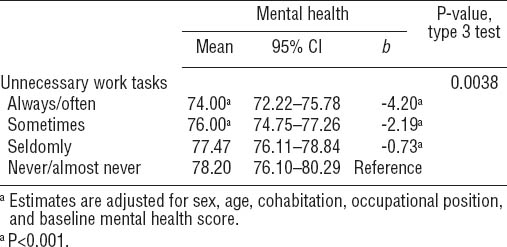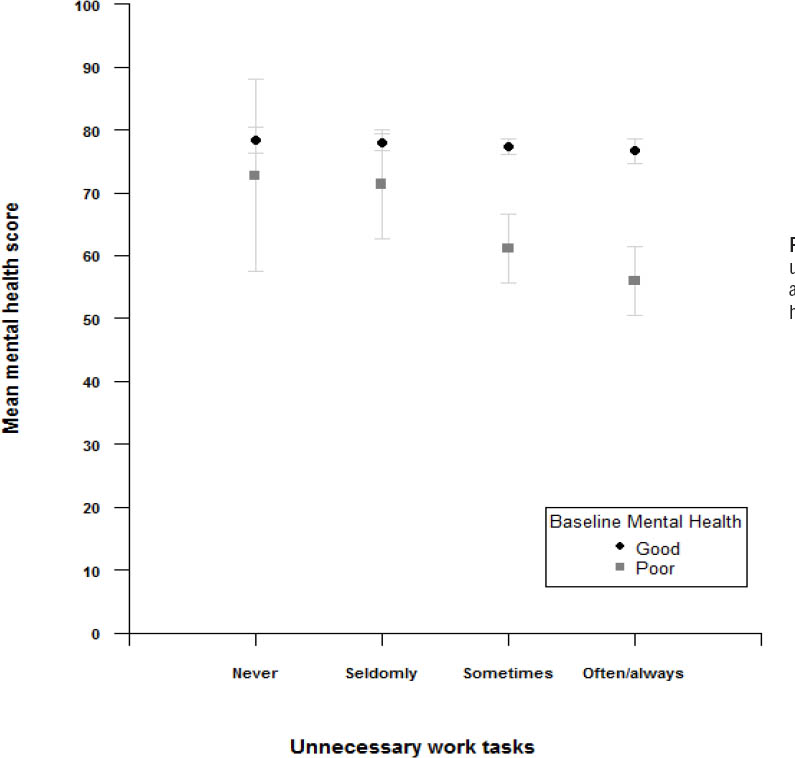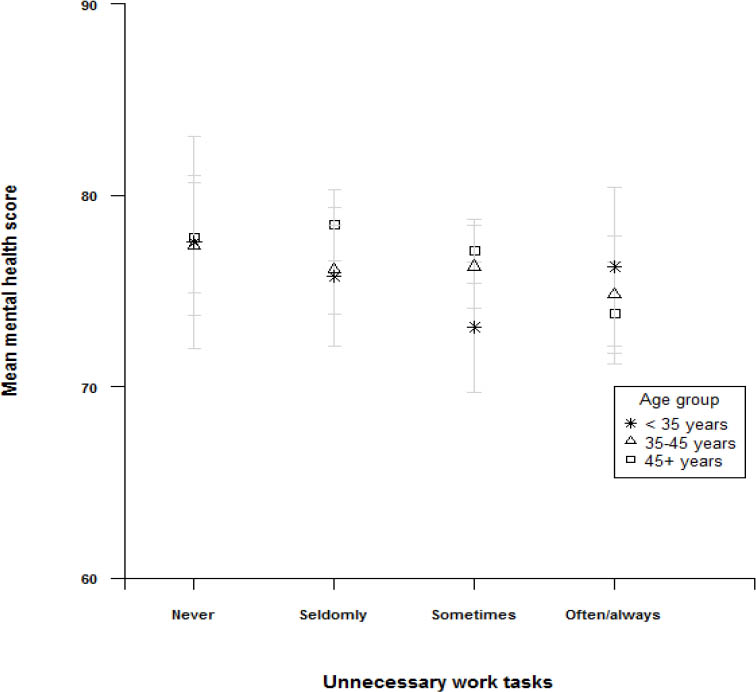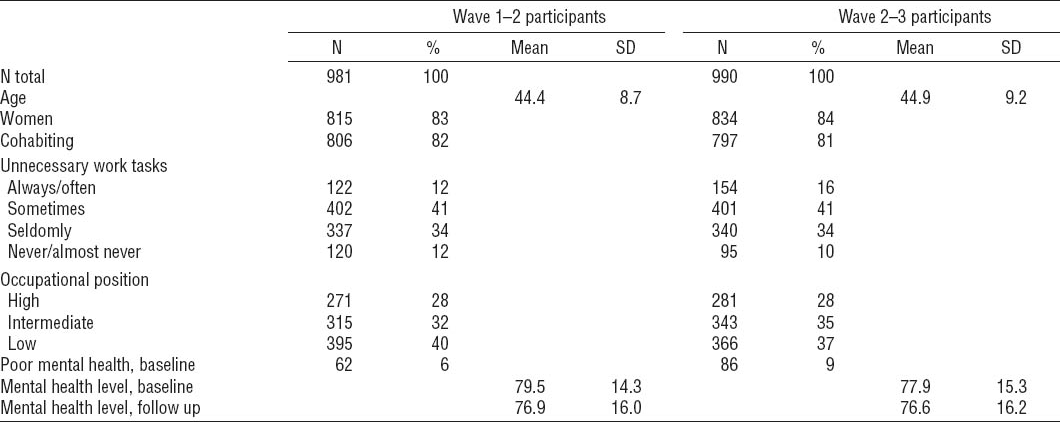Mental disorders are a leading cause of morbidity and disability across the world (1). In addition to substantial individual consequences in terms of quality of life and role impairment (2), mental disorders are associated with considerable societal costs in terms of reduced productivity, sickness absence, and treatment expenses (3, 4). According to the World Health Organization, mental health is not only defined by the absence of mental disorder, but is “… a state of well-being in which the individual realizes his or her own abilities, can cope with the normal stresses of life, can work productively and fruitfully, and is able to make a contribution to his or her community” (5, p2). Reduced mental health is not only inextricably linked with lowered quality of life (5, 6), but also bears economic and societal costs, including substantially increased risk of long-term sickness absence, even at levels well below established clinical cut-off points for mental disorder (7–11)
Previous literature linking the psychosocial work environment with reduced mental health has mainly focused on a relatively limited range of factors, including job strain, effort–reward imbalance, social support, and bullying (12–17). Norbert Semmer et al’s “stress-as-offense-to-self” framework (18) suggests new conditions that may be relevant to employee mental health, including factors that are threatening to the personal or social self-esteem of the employee. According to the theory, an individual’s social self-esteem may be threatened by behaviors that directly or indirectly signal disrespect (18). These behaviors include the assignment of what Semmer calls “illegitimate work tasks”, tasks that are perceived as offending one’s professional identity (19) and considered unreasonable or unnecessary. Whereas unreasonable tasks constitute tasks that the employee feels should be carried out by someone else, unnecessary tasks are tasks that should not be carried out at all. The assignment of either type of illegitimate task, according to the stress-as-offense-to-self perspective, may trigger stress reactions. One example is a nurse spending excessive time on documentation due to incompatible IT systems: if this activity is not considered a part of the core job role for the employee, spending prolonged time on such tasks is likely to be considered stressful (19).
Previous studies have related illegitimate work tasks to decreased well-being (18) and increased levels of stress (20), cortisol (21) and counterproductive work behavior (19). Most studies have, however, used cross-sectional designs, and – to the best of our knowledge – no study has yet examined the prospective relations between unnecessary work tasks and mental health. As the theory suggests that illegitimate tasks pose a threat to self-esteem, and self-esteem is central to mental health outcomes such as depression (18), it is likely that this exposure may affect mental health in particular.
This study examines the associations between unnecessary work tasks, which are one type of illegitimate work tasks, and mental health, hypothesizing that an increased level of unnecessary work tasks is prospectively associated with a decreased level of mental health. Further, we test exploratively, whether the association is modified by sex, age, occupational position or baseline mental health. As the experience of work tasks is likely to be affected by the mental health state of the individual, a prospective design controlling for baseline mental health is necessary to avoid circular reasoning. We use data from a cross-occupational sample of Danish human service workers, a cluster of occupational groups in which illegitimate work tasks have received considerable attention during recent years, particularly in relation to documentation considered to be excessive and unnecessary (22-23). This development has occurred in the context of new public management – a series of reforms conducted since the 1980s that introduced market-oriented management strategies to modernize the public sector and make it more efficient (24).
Methods
Data
The study was carried out as a secondary data analysis using data from the Project on Burnout, Motivation and Job Satisfaction (PUMA). PUMA was a three-wave, open cohort study designed to examine burnout among service workers. Participants in the PUMA study were recruited from seven human service organizations: (i) 10 social security offices in an urban area; (ii) a state psychiatric prison; (iii) 16 county institutions for severely disabled people; (iv) 3 somatic wards (surgical, medical, gynecological-obstetric) from two county hospitals; (v) a psychiatric ward from a psychiatric hospital; (vi) a homecare service in a rural area; and (vii) a homecare service in an urban area. Data were collected in 1999–2000 (wave 1), 2002–2003 (wave 2), and 2005 (wave 3). The response rates for PUMA ranged between 75–88% (25). The Danish Data Protection Agency (Datatilsynet) and the Scientific Ethical Committees (Videnskabsetisk Komite) in the respective counties approved PUMA. The questionnaire contained information regarding the purpose of the study, and the submission of the questionnaire was regarded as informed consent. For details on PUMA see Borritz et al (26).
Measurements
From the self-administered questionnaires we included data on unnecessary work tasks, mental health, cohabitation, and tenure. Unnecessary work tasks were measured by the item “Do you sometimes have to do things in your job which appear to be unnecessary?” with five response categories ranging from “always” to “never/almost never”. For the analyses, due to a low number of respondents indicating always having to do unnecessary tasks, we collapsed the responses always and often.
Mental health was measured by the Mental Health Inventory (MHI-5) a 5-item scale from the Short-Form Health Survey (27). The MHI-5 asks respondents “How much of the time in the past four weeks have you: (i) been very nervous, (ii) felt downhearted, (iii) felt happy, (iv) felt calm and peaceful, and (v) felt so down in the dumps that nothing could cheer you up?” We scored each item of the scale from 0–100 with higher scores indicating fewer symptoms and calculated a mean score, if participants had data on ≥3 items. Following previous studies (28–30), we defined poor mental health as a mean score of ≤52. Cohabitation was measured by asking the respondent if they lived with a partner or spouse. Tenure was measured by asking how long they had been employed at their workplace.
Furthermore, we included national Danish register data on sex, age, and occupational position (31, 32). These data were included from the Civil Registration System (31) and the Employment Classification Module (32), which includes data on an individual’s most important employment activity throughout each year. Both registers have excellent coverage of the Danish population and are considered to be of high validity for research purposes (31, 32). Occupational position was classified as high, intermediate, or low, following the European Socioeconomic Classification (33) based on the International Labor Organization’s International Standard Classification of Occupations (34).
Also, to examine if the association between unnecessary work tasks and mental health was independent from effects of more established work environment factors, we included data on psychological job demands and decision latitude at work (35). Psychological job demands were measured by a 3-item scale, assessing the demands to work fast, time pressure, and conflicting demands. A 4-item scale assessing both skill discretion and decision authority in accordance with the Demand –Control Model (35) was used to measure decision latitude. The items used to measure psychological demands and decision latitude have previously been validated against the Demand–Control Questionnaire (36).
Study population
There were 1391 individuals who participated in ≥2 consecutive waves of the PUMA study, contributing a total of 2072 observations of both baseline and follow-up data. We excluded 101 observations due to missing data on key variables (unnecessary work tasks, baseline or follow-up mental health, sex, age, cohabitation, occupational position), yielding a total 1971 observations from 1351 individuals. The characteristics of participants are shown in table 1, according to wave of baseline and follow-up data.
Statistical analysis
We examined the association between unnecessary work tasks and mean mental health level prospectively, adjusting for baseline mental health level. We applied multi-level modeling using either wave 1 or 2 as baseline and the subsequent wave as follow-up. We considered this strategy reasonable as the length of follow-up between waves 1 and 2 (median follow-up: 2.9 years) was similar to the length between waves 2 and 3 (median follow-up: 2.6 years).
All models controlled for sex, age, cohabitation and occupational position, as these factors have been related to mental health (37–39) and might be related to the level of unnecessary work tasks. We also adjusted for baseline values of mental health as we considered it likely that the experience of viewing work tasks as unnecessary could be affected by this factor. We furthermore examined whether the association was modified by sex, age, occupational position, or poor baseline mental health by including two-way interaction terms for each potential effect modifier in the model. We included the listed factors as we considered them potential vulnerability factors that could render individuals more susceptible to any effects of unnecessary work tasks. As we found a tendency towards interaction with age (P<0.10), we further examined whether this interaction was due to tenure, by adjusting for workplace tenure. Additionally, we examined whether the association between unnecessary work tasks and mental health was independent from job demands and control by adjusting for these factors.
Analyses were conducted in SAS version 9.3 (SAS Institute, Cary, NC, USA), using the procedure mixed, and figures were plotted in R. We initially specified the models with random effects for person-nested-within-workplace to account for data clustering at the levels of individuals and workplaces. When adjusting for baseline mental health, though, there was no additional effect of the person-level indicator and this parameter was left out of the analyses. We specified a random-effect interaction between the exposure and the workplace, allowing the exposure effect to vary between workplaces. This method theoretically increases the generalizability of the results, beyond those workplaces included in the study, to the background population from which they were sampled (40). We inserted the exposure “unnecessary work tasks” as a categorical predictor to not assume linearity between exposure and outcome.
Results
Unnecessary work tasks were prospectively associated with mental health, after adjusting for the baseline mental health (see table 2). The relation between unnecessary work tasks and mean mental health level appeared curvilinear, with stronger effects at the higher levels of unnecessary work tasks.
Table 2
Unnecessary work tasks at baseline and mental health at follow-up [95% CI=95% confidence interval]

We found no indication of effect-modification by sex or occupational position. There was, however, a statistically significant interaction between unnecessary work tasks and poor baseline mental (P<0.001). The stratified analyses revealed that the association between unnecessary work tasks and mental health was stronger among individuals with poor baseline mental health compared to other participants (see figure 1).
Figure 1
Mental health in relation to unnecessary work tasks (prospective analysis), stratified by baseline mental health status.

For participants with poor mental health at baseline, the b associated with the highest level of unnecessary work tasks was -17.3. For participants with good mental health at baseline this effect was only -2.8 and was statistically non-significant.
We also observed a tendency towards an interaction with age (P<0.10). As shown in figure 2, the association between unnecessary work tasks and mental health tended to be slightly stronger among older compared to younger employees. For participants aged ≥45 years, the b associated with the highest level of unnecessary work tasks was -5.7, whereas it was -4.10 and -1.97, respectively, for participants aged 35–44 and <35 years. To examine whether this tendency was explained by exposure length, we further adjusted for tenure, but this factor did not explain the tendency towards effect modification, and there was no statistically significant three-way interaction between unnecessary work tasks, age and tenure.
Figure 2
Mental health in relation to unnecessary work tasks (prospective analysis), stratified by age.

When adjusting for baseline job demands and control, the prospective association between unnecessary work tasks and mental health attenuated somewhat in the main effects analysis and became statistically insignificant. However, the interaction with poor baseline mental health remained, and for participants with poor baseline mental health there was still a similar association between unnecessary work tasks and decreased mental health, with a b of -15.2 for the participants with the highest level of unnecessary work tasks.
Discussion
We found that unnecessary work tasks were prospectively associated with decreased mental health, after adjusting for baseline mental health. This association was stronger for those with poor baseline mental health and tended to be more pronounced among older compared to younger participants. Also, the association was independent of the psychological demands and decision latitude at work, within the group with poor baseline mental health. This finding is in line with a previous study on counterproductive work behavior (19), which found that illegitimate tasks were associated with increased levels of behaviors such as taking overly long breaks, stealing or gossiping about other members of the organization. This association was independent of effort–reward imbalance at work and organizational justice. Together, these findings suggest that the stress-as-offense-to-self perspective may add information regarding the psychosocial work environment, which is not included in existing work stress models. However, given the attenuation of the main-effects association in the present analyses when adjusting for demands and control, further research is needed to clarify the extent to which unnecessary work tasks may lead to reduced mental health, for whom, and in what contexts.
We found that the association between unnecessary work tasks and mental health was most pronounced among individuals with poor mental health at baseline. This finding is in line with a study by Kottwitz et al (21), which found that illegitimate tasks were associated with increased cortisol levels among male employees with poor self-rated health but not employees with medium or good self-rated health. The effect-modification by baseline health status may be related to psychological processes that render the individual more vulnerable to the effects of illegitimate tasks. Such processes may involve self-esteem, which is thought to be central to the development of depression (41–43). It is likely that individuals with poor self-esteem are more vulnerable to threats to their social esteem, of which unnecessary work tasks constitute an example.
We also found a tendency towards a slightly stronger association between unnecessary work tasks and mental health among older compared to younger employees. This tendency was not explained by job tenure, suggesting that the underlying factor was not the duration of exposure. It is possible that age in this context acts as a status indicator and that employee expectations regarding the performance of unnecessary tasks differ according to age. This might explain why older employees possibly experience the performance of unnecessary tasks as more offensive to the self, and consequently more detrimental to their mental health. The direction of such effect modification was, however, not hypothesized before analyzing the data and the result should be interpreted as hypothesis-generating rather than confirmatory.
It is central to the concept of illegitimate tasks that the legitimacy of the work tasks is subjectively experienced and linked closely with the professional role identity of the employee. Work tasks are unlikely to be experienced as illegitimate if they are in line with or affirm the core role of the employee – in this context the same tasks are likely to be interpreted as “part of the job” (18). Consequently, the evaluation of the necessity of work tasks, and their legitimacy, likely varies across organizational levels. It also seems unlikely that work tasks would be assigned were they not considered necessary from some perspective. The process of eliminating unnecessary work tasks, then, is likely to be two-dimensional: First, eliminating tasks that are actually considered unnecessary throughout the organization, and second, working towards a mutual understanding of the necessity of work tasks across organizational levels. Further research to identify specific interventions that may reduce the levels of unnecessary work tasks in different organizational contexts seems warranted.
Strengths and limitations
The strengths of this study include the prospective design, the adjustment for baseline mental health, and the relatively large dataset that allowed analyses of effect modification. To the best of our knowledge, this is the first study that has prospectively examined the association of illegitimate tasks and mental health. These strengths should be weighted against the limitations of the study. First, we measured the exposure of unnecessary work tasks with a single item and could not assess unreasonable work tasks. Because this study was a secondary data analysis, we chose the exposure measurement from the data available. However, the single-item measurement may have decreased the precision of the analyses and increased random error (44). Further, the item phrasing includes an indication of frequency (“do you sometimes have to do…”) that does not correspond well to all response categories (eg, “seldom”). This may have confused some respondents and decreased the measurement reliability.
Second, we measured both exposures and outcomes by self-report. Such analyses may raise concerns of common method variance inflating the associations (45, 46). Although we addressed such bias by conducting prospective analyses accounting for baseline mental health (45), concerns regarding common method variance remain a valid limitation of this study. However, it should be noted that, because the experience of unnecessary work tasks is linked with the professional identity of the employee, it is the subjective experience that is of main interest rather than an objective assessment of whether or not the work tasks in question are necessary. Also, no fully objective assessments of mental health exist, as even expert ratings are based partly on the reporting of the individual. Consequently, it does not seem feasible to examine the relation between unnecessary work tasks and mental health without relying on self-reported data.
Finally, the study population consisted of employees in human service organizations primarily within the public sector. This may decrease the generalizability of the findings to organizations outside this field. As most research on illegitimate tasks has focused on public-sector employees, future research on this issue outside the public sector context seems warranted.
Concluding remarks
Our findings suggest that the elimination of unnecessary work tasks may be beneficial for employee mental health, particularly among employees with pre-existing poor mental health. Such interventions could target the elimination of tasks that are experienced as unnecessary throughout the organization and the achievement of a joint understanding of the necessity of tasks that are experienced as unnecessary only at some organizational levels.




